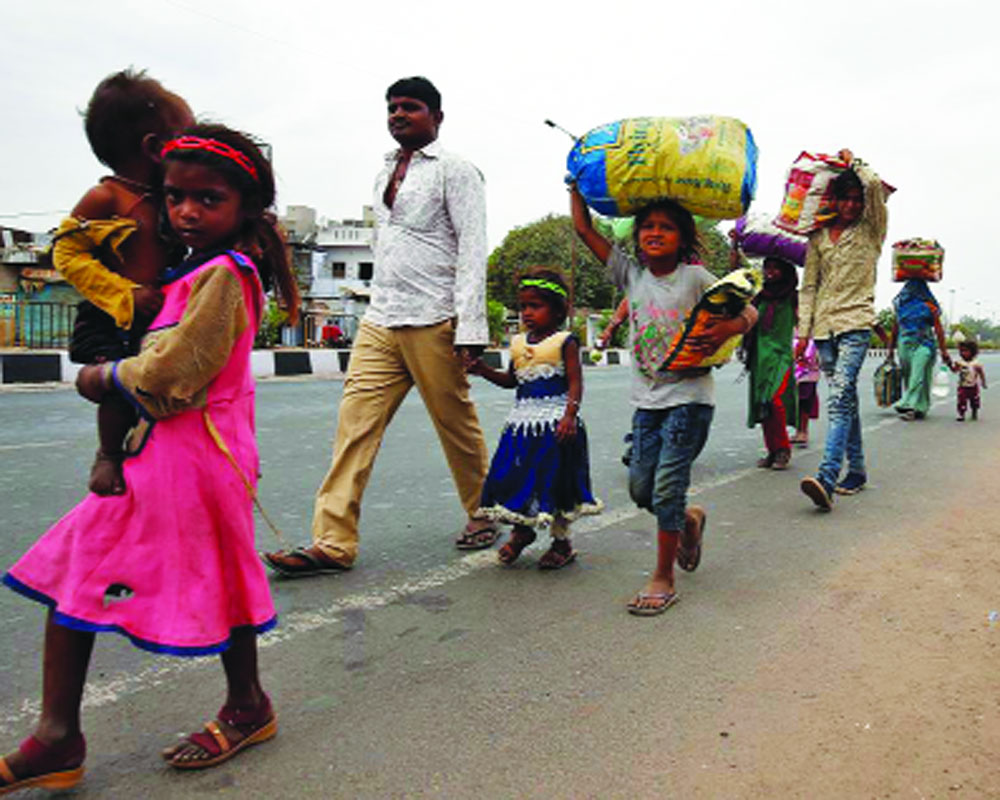Labourers don’t have bank accounts and are out of the welfare arc. As they migrate, the flu could swamp rural India
State borders now present a picture of reverse human migration as thousands of daily wage earners, casual labourers and vendors, who do not have a bank account or even money to save, trudge back to their home States despite a lockdown. With no buses, trucks or trains, they have decided to surrender to destiny and return to their villages on foot. For even without a day’s work, they would not be able to get food for their families or rent the hovel they live in at slum clusters. Food shortages and uncontrolled hoarding have meant that they have not been able to get basic rations over the last two days, leading to widespread panic. It is a hard choice between starvation and the flu. In the absence of soup kitchens or shelters, the vast numbers of India’s unorganised labour market won’t even be able to avail the economic relief measures announced by the Government. And they are going back home, thinking they will live off the land with whatever subsistence farming can give them. There will be a roof over their heads where they do not have to pay rent. There’s no agricultural activity either, signalling a low output of food crops that may foist another problem on the nation later. This is a humanitarian crisis like no other. Let us not forget migrant returnees may have already unwittingly carried Coronavirus into India’s vast rural swathes, which are unaware, unprepared and under-equipped to deal with the criticality of a health emergency of this scale. And considering they are travelling in clusters, all of them could be potentially infected by the time they reach from carriers among them. Then the whole purpose of Prime Minister Narendra Modi’s 21-day lockdown, to break the transmission cycle of the virus, would get defeated. Worst, rural India could be swamped. Assuming these “non-banked” people even avail of the Pradhan Mantri Gareeb Kalyan Anna Yojana and get 5 kg per person rice/wheat each month for the next three months in addition to 5 kg of rice/wheat that they already get, they would rather use these benefits at their village than be homeless and helpless in cities. This unprecedented flight of migrant workers out of our cities, be it Rajasthan or Telangana, poses a new challenge in our fight against the virus. Containing and settling them at shelters in a specified location pose the biggest challenge. Frankly, India has not had time to prepare for the human dimension of the virus or the lockdown. The WHO did lead it up the garden path, not pressing the panic buttons early on. There was a denial about the inevitability of community explosion, given the density of our population and the failure of Indians to take to social distancing, isolation and quarantining protocols seriously. Now experts are saying the lockdown would have been effective had it been enforced a week or two before and that we are still two steps behind the virus.
According to reports, over 2,000 daily wage workers in Ahmedabad took to their feet and other means of transport for their homes back in Rajasthan. Thousands of wagers are walking long distances, even to the extent of 100 and 300 km, and often on empty stomach to reach their villages. According to the Economic Survey of 2018-19, over 90 per cent of our total workforce is “informal.” The worrying part is that the NITI Aayog estimates show that India’s informal sector employees are approximately 85 per cent of all workers. The Economic Survey of 2016-2017 had indicated an annual flow of close to nine million migrants among States between 2011 and 2016. Internationally, too, migrants are posing newer challenges to managing the epidemic. Borders throughout the Middle East tend to be porous with political refugees, economic migrants and others often travelling along informal routes. It is very difficult under such circumstances to monitor who is entering and leaving what country. Also, these people cannot access public healthcare. This has caused much of the spread in nations around Iran, too. Now imagine that with our States. We are quite precariously perched but trying to flatten the curve would mean not just lockdowns or an economic package but aggressive testing, isolation and surveillance. Where are these facilities in rural India? If we are to ride this out and look ahead, there can be no two ways about rearranging a nation’s health priorities. As the PM said, Jaan hai to Jahaan hai. Delhi’s Central vista makeover, at Rs 20,000 crore, can wait!


























